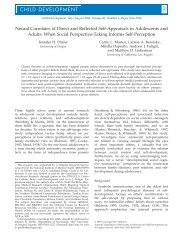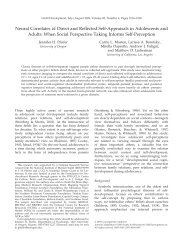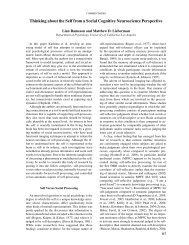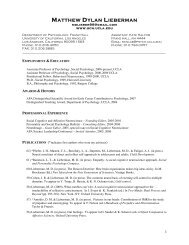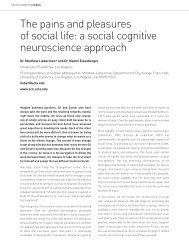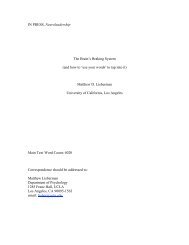In Progress – DO NOT CITE Attributional inference across cultures ...
In Progress – DO NOT CITE Attributional inference across cultures ...
In Progress – DO NOT CITE Attributional inference across cultures ...
Create successful ePaper yourself
Turn your PDF publications into a flip-book with our unique Google optimized e-Paper software.
Culture, Attribution, & Automaticity<br />
20<br />
talking. The EA targets were both individuals born and raised in Japan. For each target,<br />
a 20 second ‘happy’ clip and a 20 second ‘neutral’ clip were selected. Thus for each of<br />
the four targets, a happy clip and a neutral clip were prepared for a total of eight clips that<br />
were used in the study. Each participant was shown an EA happy, an EA neutral, a US<br />
happy, and a US neutral video clip. From each target either the happy or neutral clip was<br />
presented to each participant such that targets were only seen once during an<br />
experimental session. Each target was equally likely to be presented as happy or neutral<br />
in a given session. The order of clip presentation was counterbalanced <strong>across</strong> participants.<br />
Cognitive load was produced using the tone-counting procedure employed in studies 1-3.<br />
Results and Discussion<br />
We first analyzed whether EA participants made strong correspondent <strong>inference</strong>s<br />
when making attributions for US targets. 4<br />
As seen in figure 5, participants made strong<br />
correspondent <strong>inference</strong>s to US targets as evidenced by higher ratings of dispositional<br />
happiness for happy behavior than neutral behavior, F(1,61)=26.75, p.2. Under cognitive load, correspondent <strong>inference</strong>s to<br />
US targets were also stronger to happy (M H =10.39) than neutral (M N =6.48) targets,<br />
t(30)=7.11, p



